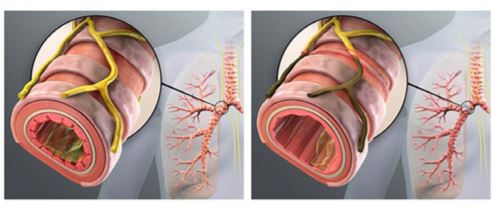Treating COPD with targeted lung denervation (TLD)
Published 21 Feb 2022 • By Claudia Lima
Chronic obstructive pulmonary disease (COPD) is a chronic inflammatory disease of the bronchial tubes, the main cause of which is smoking. However, it affects both smokers and non-smokers.
In the UK, nearly 4.5% of the adult population aged over 40 is affected.
Recently there have been some scientific developments in the treatment of COPD, which include targeted lung denervation (TLD) therapy.
What is targeted lung denervation?
To learn all about it, read our article!

Chronic obstructive pulmonary disease or COPD is characterised by a progressive narrowing and permanent obstruction of the airways.
About 80% of cases are caused by smoking, although contrary to popular belief, smoking is not the only risk factor. The disease can also be caused by air pollution, occupational exposures in industrial settings and genetic predisposition, among others.
COPD used to be diagnosed more often in men than in women, but today it affects almost as many women as men. This is mainly due to an increase in smoking among women. Women also develop COPD earlier than men, and suffer with more serious forms of the disease.
What are the symptoms and complications of COPD?
The main symptoms of COPD are chronic cough, sputum, breathlessness and dyspnoea.
The course of the disease is punctuated by exacerbations, which are episodes of symptoms worsening. One way of measuring dyspnoea in COPD patients is the Modified Medical Research Council (mMRC) dyspnoea scale, which measures the risk of exacerbation using a five-stage scale, from 0 to 5.
The most frequent complications of COPD are emphysema and chronic respiratory failure, but patients can also suffer from musculoskeletal and psychiatric consequences of the disease.
How is COPD diagnosed?
The diagnosis of COPD is based on the observation of symptoms which should be present at least three months a year and for at least two consecutive years. If the symptoms suggest COPD, the doctor will prescribe a specific test, called a pulmonary function test (PFT), which is carried out using a spirometer that measures the patient's respiratory capacity.
The PFT may be supplemented by a blood gas test and a walking test to assess the impact of the disease on the patient's daily life. Also, an X-ray of the lungs can be used to visualise the lesions.
The symptoms of COPD develop slowly and are often wrongly linked to ageing and therefore often overlooked.
How can COPD be prevented and treated?
The first step in treating COPD is to stop smoking and reduce exposure to second-hand smoking.
Then, depending on the severity of the disease, bronchodilators, corticosteroids and antibiotics are prescribed to ease the symptoms. Pulmonary rehabilitation sessions can be provided to improve breathing capacity. Treatment of patients in the respiratory failure stage requires oxygen therapy.
In the case of severe COPD, surgical options are available; they include lung volume reduction surgery and single or double lung transplantation. Endobronchial valve placement may be an alternative to surgery, provided all the conditions are favourable.
Vaccination against influenza (once a year) and pneumococcal disease (once in 5 years) is compulsory for those affected by COPD. Vaccination against Covid-19 is highly recommended.
To prevent COPD, it is necessary to create and maintain good breathing habits such as avoiding smoky and polluted areas, increasing breathing capacity by breathing through the abdomen, practising blowing out candles, exercising, avoiding tight clothing that constricts the abdomen and getting informed about the weather conditions before going out so as not to breathe in air that is too hot or too cold, which makes breathing more difficult.
What is targeted lung denervation (TLD)?
In 2019, a US company named Nuvaira™ launched a large-scale international trial for a non-drug treatment for COPD. This trial is taking place in about 20 medical centres in the United States and 13 centres in Europe. The purpose of this study is to evaluate the effectiveness of targeted lung denervation (TLD) in treating COPD.
The new treatment, called Airflow 3, consists of introducing a catheter through the patient's mouth, with the help of a video endoscope, and performing radiofrequency thermolysis in both lungs. It is a complementary approach to treating COPD.
Radiofrequency is based on the emission of very high frequency electromagnetic waves that pass through the skin and produce heat in the subcutaneous tissue. The heat produced acts on the inside, without burning the surface, i.e. the skin. This is called thermolysis, or thermal decomposition.
This method can destroy and deactivate about 50% of the bronchial nerves which control, among other things, bronchial muscles contraction. This contraction is abnormal in COPD. The treatment is non-surgical, it is performed in a single procedure called bronchoscopy and is carried out under general anaesthesia.
Source: Nice, centre d’essai pour une étude internationale
The expected results include better breathing and a smaller risk of lung infections such as bronchitis or pneumonia, and thus fewer exacerbations. The improvement of patients' physical and psychological state is also evaluated.
This trial is aimed at patients aged 40 to 75, who are diagnosed with COPD and meet certain eligibility criteria, such as a minimum of 2 exacerbations in the past year, total absence of smoking for at least 2 months, taking a maintenance treatment, etc. Patients must also have a certain BMI (body mass index), oxygen level (oxygen saturation) and FEV1 (forced expiratory volume in 1 sec), etc.
As of today, nearly 300 patients have benefited from this therapeutic trial, which is still ongoing. In the US, it is still considered an experimental device, and is awaiting the FDA approval. In Europe, the trial has received CE marking approval. Nuvaira™ has just secured an additional $50 million to be able to complete the trial.
Participation in this international study is still possible, all information is available on their website.
Was this article helpful to you?
Give it a like and share your thoughts and questions with the community in the comments below!
Take care!
Sources :
Bronchopneumopathie chronique obstructive, inserm.fr
BPCO : symptômes, causes, traitements et prévention, vidal.fr
Traitement de la BPCO en état stable, msdmanuals.com
Un traitement innovant pour certaines insuffisances respiratoires, francebleu.fr
Le CHU de Brest participe à une étude mondiale sur la BPCO, ouest-france.fr
Nuvaira annonce une étape importante pour l'essai pivot Airflow 3 pour la BPCO, prnewswire.com


 Facebook
Facebook Twitter
Twitter


